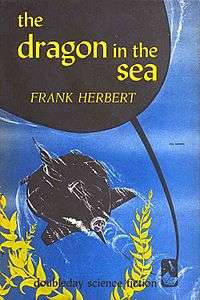The Dragon in the Sea
 | |
| Author | Frank Herbert |
|---|---|
| Cover artist | Mel Hunter[1] |
| Country | United States |
| Language | English |
| Genre | Psychological thriller |
| Publisher | Doubleday & Company |
Publication date | 1956 |
| Media type | Print (Hardcover & Paperback) |
| Pages | 192 pp |
The Dragon in the Sea (1956), also known as Under Pressure from its serialization, is a novel by Frank Herbert. It was first serialized in Astounding magazine from 1955 to 1956, then reworked[2] and published as a book in 1956. (A 1961 2nd printing of the Avon paperback, catalog # G-1092, was titled 21st Century Sub with the original title in parentheses.) It is usually classified as a psychological novel.[3]
Plot
Set in a near-future earth, the West and the East have been at war for more than a decade, and resources are running thin. The West is stealing oil from the East with specialized nuclear submarines ("subtugs") that sneak into the underwater oil fields of the East to secretly pump out the oil and bring it back. Each manned by a crew of four, these submarines undertake the most hazardous, stressful mission conceivable, and of late, the missions have been failing, with the last twenty submarines simply disappearing.
The East has been very successful in planting sleepers in the West's military and command structures, and the suspicion is that sleepers are sabotaging the subs or revealing their positions once at sea. John Ramsey, a young psychologist from the Bureau of Psychology (BuPsych), is trained as an electronics operator and sent on the next mission, replacing the previous officer who went insane. His secret mission is to find the sleeper, or figure out why the crews are going insane.
Major themes
Typically for Herbert, psychology and religion (the title comes from a quote from the Book of Revelation) play a large role in the narrative, as John Ramsey comes to understand the nature of the subtug crews and how they carry out their missions.
The technology of the submarines towing large bags filled with the surreptitiously pumped oil described in the books may have been an inspiration for the invention called the Dracone[4][5] for which development started in the year following Herbert's serial.
Reception
Galaxy reviewer Floyd C. Gale praised Dragon in the Sea as "a dramatically fascinating story. . . . [a] tense and well-written novel."[6] Algis Budrys described it as "hypnotically fascinating," praising Herbert's "intelligence, sophistication, [and] capacity for research" as well as his "ability to write clean prose as an unobtrusive but effective vehicle for a cleanly told story."[7] Anthony Boucher found the novel "as impressive in its cumulative depiction of a specialized scientific background as anything since Hal Clement's Mission of Gravity."[8] Spider Robinson, reviewing a mid-1970s reissue, faulted the novel's characterizations, saying "there are no real people in it, only psychological types and syndromes walking around on legs."[9]
J. Francis McComas praised the novel in The New York Times, comparing it to Forester and Wouk and declaring, "In this fine blend of speculation and action, Mr. Herbert has created a novel that ranks with the best of modern science fiction."[10]
Awards
The Dragon in the Sea tied for number thirty-four in the 1975 Locus All-Time Poll.
References
- ↑ isfdb
- ↑ Liukkonen, Petri. "Frank (Patrick) Herbert". Books and Writers (kirjasto.sci.fi). Finland: Kuusankoski Public Library. Archived from the original on 10 February 2015.
- ↑ "Frank Herbert" - nnbd.com "The book showcased his interest in human psychology, especially as applied to power and leadership, and it also predicted, by two decades, the political ramifications of oil dependency and production."
- ↑ O'Reilly, Timothy (1981). "Chapter 2: Under Pressure". Frank Herbert. Frederick Ungar Publishing Co., Inc. Retrieved 2009-05-09.
[the name was an] overt acknowledgment of the source of [the] idea
- ↑ "The Papers of Sir William Hawthorne". Janus. Retrieved 2009-05-09.
christined Dracone [because it was] the nearest word in Greek for a mythical monster such as a sea serpent
- ↑ "Galaxy's 5 Star Shelf", Galaxy Science Fiction, July 1955, p.99
- ↑ "Galaxy Bookshelf", Galaxy Science Fiction, April 1966, p.67
- ↑ "Recommended Reading," F&SF, June 1956, p.102.
- ↑ "Galaxy Bookshelf", Galaxy Science Fiction, August 1977, p.141.
- ↑ "Spaceman's Realm", The New York Times Book Review, March 11. 1956
External links
- The "Under Pressure" chapter from Timothy O'Reilly's critical study of Frank Herbert, Frank Herbert
- Review
External links
- The Dragon in the Sea title listing at the Internet Speculative Fiction Database